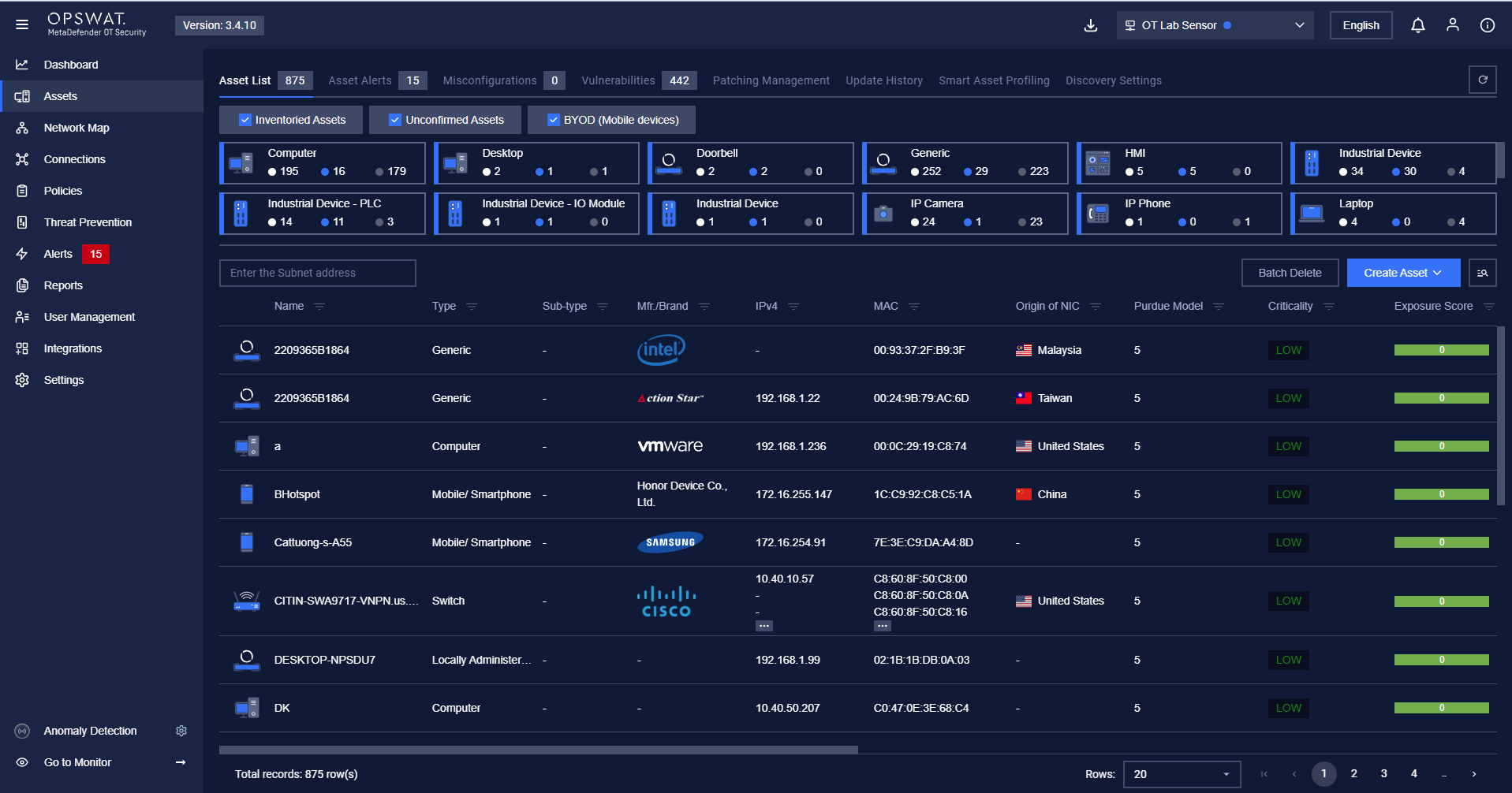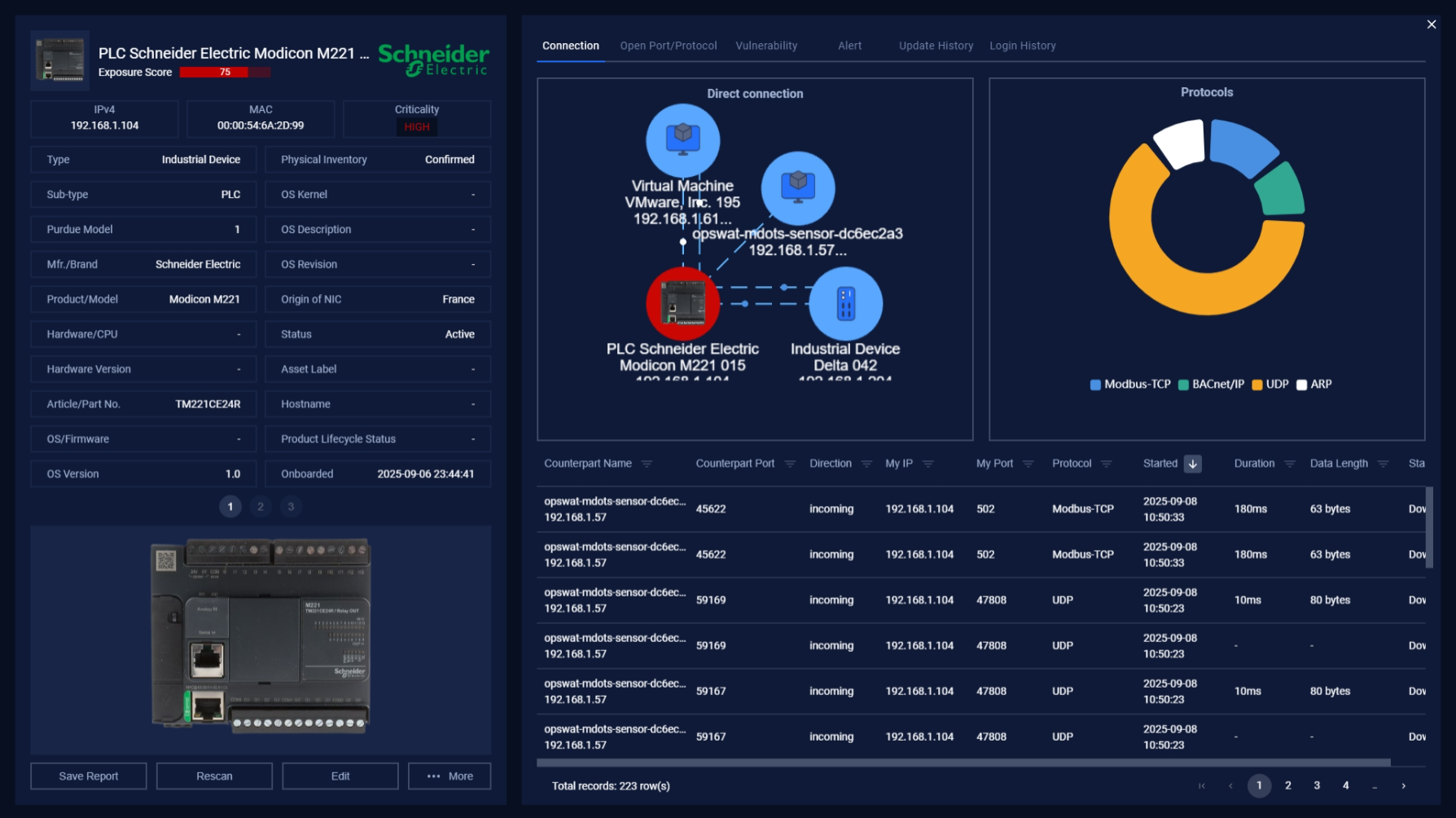The list of devices is accessible under Investigate → Assets → Asset List.
Currently, we also cache assets' data at Enterprise Manager for the improvement of performance and to make essential asset info available to users.
The list of assets contains all asset information in the system.

Each row contains the following fields:
- Basic information of that device, such as Name, IP, MAC, Criticality of Asset, Type, Sub-type, Vendor/Brand, OS, Origin of NIC, and exposure score.
- Detailed information such as product model, hardware/CPU, hardware version, part No., OS version.
- Also, the status of the device in the system, such as Onboarded Time, Current Status, Asset Label, Agent that detected that device, is shown, or the device learning time status.
Note: You can sort a field in ascending or descending order by clicking on its name.
You can perform actions on a device while on a list of devices, such as edit its details, delete the device, or clone the device by tapping "..." on each device's record and selecting Edit/Delete/Clone. For more details, refer to “Device Manipulation”.

Filter
We support searching and filtering on the list of devices:
- You can enter a value for 1 or more fields, and the result list and the number of total records will be updated according to the value(s) you entered.
| Index | Field | Data type | Type of input | Support multi-input | Note |
|---|---|---|---|---|---|
| 1 | Name | Text | Input text | No | |
| 2 | Type | Text | Select from drop-down list | Yes | |
| 3 | Sub-type | Text | Select from drop-down list | No | |
| 4 | Vendor/Brand | Text | Select from drop-down list | No | |
| 5 | Product/Model | Number | Input number | No | |
| 6 | Hardware/CPU | Text&Number | Input number and text | No | |
| 7 | Hardware version | Text&Number | Input number and text | No | |
| 8 | Article/Part No. | Text&Number | Input number and text | No | |
| 9 | Operating System | Text&Number | Select from drop-down list | No | |
| 10 | OS Version | Text&Number | Input number and text | No | |
| 11 | IP | Number | Input number in IP address format (e.g. 192.168.1.102), IP netmask format (e.g.192.168.1.0/24) | No | |
| 12 | MAC | Text&Number | Input number and text in MAC address format (e.g. A1:B2:C3:D4:E5:F6), | No | |
| 13 | Origin of NIC | Text | Select from drop-down list | No | |
| 14 | Purdue Model Level | Number | Select from drop-down list | Yes | |
| 15 | Criticality of Asset | Text | Select from drop-down list | No | |
| 16 | Exposure score | Number | 0 to 100 | No | |
| 17 | Onboarded | Date time | Select from pop-up calendar and clock | No | |
| 18 | Status | Text | Select from drop-down list | No | |
| 19 | Site | Text | Select from drop-down list | No | |
| 20 | Asset Label | Text | Input text | No | |
| 21 | Agent | Text | Select from drop-down list | No | |
| 22 | Learning status | Icon | Learning/Completed | No | |
| 23 | Host Name | Text | Input text | No | |
| 24 | System Description | Text | Input text | No | |
| 25 | Protected By | Text | Input text | No | |
| 26 | Product Lifecycle Status | Text | Input text | No |
- You can change the order of the fields displayed on the list by clicking "..." -> “Filter preference,” then drag and drop the fields to arrange them in the desired order.
- You can choose to show/hide the fields in the list by clicking "..." -> “Filter preference” and ticking/unticking the box on the left of the field name.
- You can save a custom filter for your convenience when you need to reuse it in the future. Enter values into the fields to filter, then select "..." -> "Create filter," and give a name for your filter. Every time you come back, click on "..." -> Your saved filter to apply it.
- You can update your saved custom filters by editing/adding values to the fields and selecting "..." then "Save filter”.
- You can delete a saved custom filter by selecting the “…” → “X” button on the saved filter.
Note:
- When you select a type and then select a Purdue model, if the selected type is not included in the chosen Purdue model, the type will be discarded, and you will need to choose another type.
- When you select a sub-type and then a type, if the selected sub-type is not included in the chosen type, it will be discarded, and you'll have to choose another sub-type.

